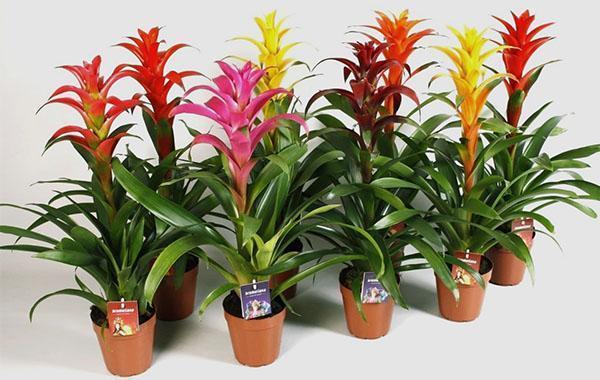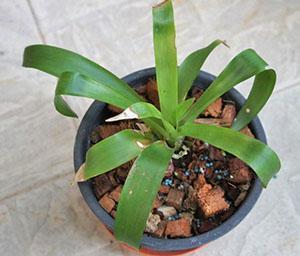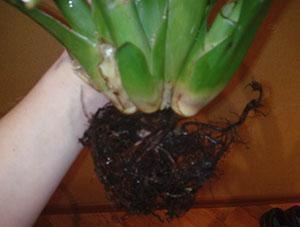Care and transplantation of guzmania at home
 Guzmania is an epiphyte plant. In humid tropical climates, the seed grows on the bark of a dead tree. The roots serve for fixing, the guzmania receives the necessary nutrition through the leaves, which form a basal rosette. At home, the guzmania is patient in care and transplantation, but it does not tolerate excessive moisture. The plant loves a bright habitat, frequent spraying. However, water droplets, like lenses, can burn the plant if it is exposed to the sun at this time.
Guzmania is an epiphyte plant. In humid tropical climates, the seed grows on the bark of a dead tree. The roots serve for fixing, the guzmania receives the necessary nutrition through the leaves, which form a basal rosette. At home, the guzmania is patient in care and transplantation, but it does not tolerate excessive moisture. The plant loves a bright habitat, frequent spraying. However, water droplets, like lenses, can burn the plant if it is exposed to the sun at this time.
Read also:arrowroot care at home with a photo
Guzmania breeding methods

The lifespan of a plant is measured by the time from germination to maturation of the seeds. Having given offspring, the guzmania dies, but first leaves daughters that budded from the main plant.
Reproduction of guzmania is possible:
- seeds;
- children.
The seed propagation method is chosen if it is impossible to purchase cuttings.
When a Guzmania transplant is required
 First and only time guzmania transplanted after purchase at a flower shop. Usually they sell a flowering plant, which means that in six months the top will dry out and the plant will die. It is necessary to take care that the plant blooms for a long time, to get children who will continue the race. The plant was carefully removed from the shipping container.
First and only time guzmania transplanted after purchase at a flower shop. Usually they sell a flowering plant, which means that in six months the top will dry out and the plant will die. It is necessary to take care that the plant blooms for a long time, to get children who will continue the race. The plant was carefully removed from the shipping container.
A bowl for guzmania is selected with a depth of no more than 12 cm, of which 2 cm will be a drainage layer.
The soil can be used commercially available for bromeliads or compose yourself from equal parts:
- turf land;
- coarse river sand;
- finely crushed sphagnum moss;
- peat.
Add a little charcoal, pine bark, ceramic chips. Drainage is arranged from shards and expanded clay balls. The roots of the plant are weak, therefore, when transplanting, the soil must be compacted carefully.
Guzmania breeding at home
 The life cycle of a plant is three years on average. When buying an adult copy, you need to know that in the future you will have to take care of renewal.
The life cycle of a plant is three years on average. When buying an adult copy, you need to know that in the future you will have to take care of renewal.
After flowering, the main plant will dry out and die off, but leave offspring. It is necessary to prepare a replacement for young children.
Seed propagation
 The sowing soil is made up of equal parts of sand and peat. Disinfect the seeds by holding them a little in a pink solution of potassium permanganate. After drying the planting material to flowability, it is laid out on the soil surface. The seeds are very small, the top layer, where they are located, should not be allowed to dry out. There must be high humidity in the shelter.
The sowing soil is made up of equal parts of sand and peat. Disinfect the seeds by holding them a little in a pink solution of potassium permanganate. After drying the planting material to flowability, it is laid out on the soil surface. The seeds are very small, the top layer, where they are located, should not be allowed to dry out. There must be high humidity in the shelter.
Seed germination occurs in the light in the soil, stable 250 C, better with bottom heating. The sprouts will appear in three weeks.
After a month, it is necessary to unpack the guzmania into separate cups. The plant develops quickly and soon catches up with the planted children.
When is it better to transplant guzmania
 Guzmania bloom is long and occurs in the summer. The faded plant dies slowly, while feeding several children. Growing up children within 2-4 months acquire a weak root system, but are attached to the mother bush. By the time the sprouts reach 15 cm in growth, the roots will definitely appear.First, it's a good idea to familiarize yourself with the methods of transplanting Guzman children by watching the video:
Guzmania bloom is long and occurs in the summer. The faded plant dies slowly, while feeding several children. Growing up children within 2-4 months acquire a weak root system, but are attached to the mother bush. By the time the sprouts reach 15 cm in growth, the roots will definitely appear.First, it's a good idea to familiarize yourself with the methods of transplanting Guzman children by watching the video:
There are two ways to transplant guzmania:
- Dry a lump of earth in a pot until flowing, turn the lump over and put it on a cutting surface. With a sharp knife, carefully separate all the babies from the mother bush and put them in some water. This will make the roots more elastic.
- Leave one baby without digging out of the ground, but remove the remaining bush with layering. The young plant will bloom next year.
 If the pot allows you to leave several daughter plants. In this case, only the middle dried part of the plant is cut out. In any case, such a plant will need to be renewed again in a year.
If the pot allows you to leave several daughter plants. In this case, only the middle dried part of the plant is cut out. In any case, such a plant will need to be renewed again in a year.
How to transplant Guzmania children correctly?
Planting young plants should be carried out in a prepared substrate with the expectation that the plant will not be transplanted for three years.
The pot should be 12-15 cm in diameter and 12 cm deep. We lower the plant into a special recess, add the earth along the edges and slightly compact it. In this case, the soil should be moderately moist. The plants are not watered into the ground, but into the funnel of leaves. If the water has not been absorbed, after a while it is removed with a blotter.
 The separated children are covered in a polyethylene cap and create a greenhouse with a temperature of 28-30 degrees. Children grow up quickly, take care of them like adult plants. Watering the plants is done in the center of the leaves. Top dressing in solution is added there too. But young plants have enough nutrients in the substrate.
The separated children are covered in a polyethylene cap and create a greenhouse with a temperature of 28-30 degrees. Children grow up quickly, take care of them like adult plants. Watering the plants is done in the center of the leaves. Top dressing in solution is added there too. But young plants have enough nutrients in the substrate.
Care of young plants
 After transplanting, the first watering is plentiful, a clod of earth is soaked and water is poured into the outlet. In this case, the water should be soft, filtered and settled for two days. Watering with hard water is detrimental to guzmania. Magnesium and calcium salts are not required for it.
After transplanting, the first watering is plentiful, a clod of earth is soaked and water is poured into the outlet. In this case, the water should be soft, filtered and settled for two days. Watering with hard water is detrimental to guzmania. Magnesium and calcium salts are not required for it.
The pot in the first place is placed in a shaded place, after 1-2 weeks it is set to a permanent place. Shelter at this moment is no longer needed. It is better to transplant the plant in spring, but if necessary, you can at any time. The main thing is to wait for the development of the root system, which could give the plant vitality.
In nature, plants grow in colonies and very densely, creating clumps from plants of all generations. At home, thickening can lead to a lack of flowering. Plants are demanding on the level of light. Therefore, it is optimal to plant each guzmania in a separate bowl.